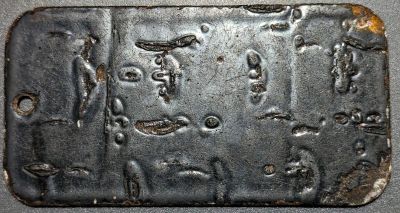An enamel staff bus pass

(W. Alexander & Sons Leyland Tiger bus, courtesy Wikipedia)
W.Alexander & Sons
W. Alexander & Sons were a Scottish bus company, based in Falkirk, in the central lowlands. Halfway between Glasgow and Edinburgh, it has a population of around 35,000 (not to be confused with the local government area of the same name which covers 160,000 across multiple towns).
Walter Alexander worked in Camelon Foundry, repairing bicycles with his brothers in the evenings and weekends. In 1902 he opened a general store in Camelon that offered bicycle sales, repairs and hire. He had acquired a motor lorry which he used for haulage work. In 1913 he launched Alexander’s Motor Services by fitting the lorry out with wooden seats and a hood over it, with bicycle lamps fitted inside. He used this to run a bus service transporting people between Falkirk, Bonnybridge, and Denny for the price of 1d.

(Walter Alexander’s 1923 charabanc, also known as the “Glass Bus”, a Leyland 40 seater used on the Falkirk & Bonnybridge Route, courtesy Falkirk.gov.uk).
He acquired his first bus in 1919, and by 1924 the company had 40 busses and formed “W. Alexander & Sons Ltd”, including his son, also called Walter.
The company was purchased by Scottish Motor Traction Company, although retaining their identity, and absorbing other companies under the Alexander brand. With bus services about to be nationalised, in 1948, Walter Alexander & Co. (Coachbuilders) Ltd was setup to keep bus manufacturing in private hands. In 1963 the then Scottish Bus Group was restructured. The “Alexander” name, the largest bus operator in Scotland, was kept for the areas it serviced, it no longer appeared on vehicles after this time.
The pass

Although I wasn’t able to get any information about the pass when I acquired it, the pass itself is quite informative. It is very large – 56x118mm (2 1/2″ x 4 1/2″), made of enameled steel. The text reads:
“Alexander & Sons Ltd
Duty pass no. 79
This duty pass valid only on
vehicles operated by the company
it must be returned
immediately to the issuing
office when the holder has
completed his or her journey.”
The reverse is plain black enamel:

I also have a round pass of the same material (Pictured next to each other for size):

These larger passes were evidently not designed to be carried regularly or for long periods, hence the instruction that it be returned immediately to the issuing office once used. The company did produce numerous tokens for passenger use, which are displayed in this WorldOfCoins post.


Leave a Reply